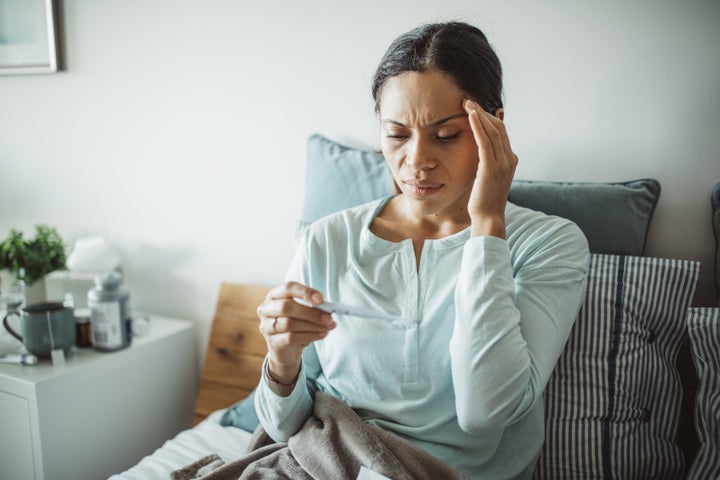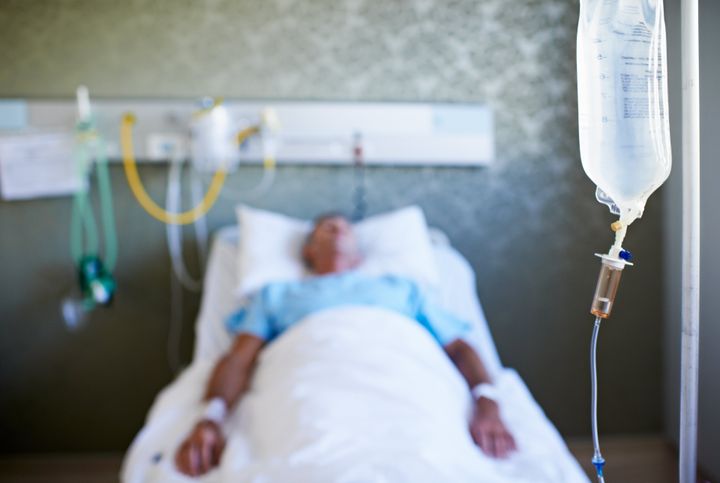There’s a critical point, somewhere around the second week of coronavirus symptoms, where patients usually start to recover. Sometimes, though, they don’t. Some people can take a turn for the worse even after they’ve started to feel somewhat better. The progression of symptoms is one of the more mysterious elements of this illness.
While the symptoms can escalate quickly, the more “prolonged course” of Covid-19 makes it unlike influenza or other similar respiratory illnesses, said William Schaffner, a professor of medicine in the Division of Infectious Diseases at the Vanderbilt University School of Medicine.
“Once on a ventilator, patients also seem to be on those ventilators for longer than comparable patients who had the flu and were also seriously ill,” he said.
Why do patients who appear better suddenly get worse? And who is more susceptible to this longer progression of symptoms?
Covid-19’s Path Through The Body
To understand why some people recover at a better rate than others, we first need to understand the mechanics of how coronavirus infects the body.
As you probably know, the novel coronavirus is a respiratory virus. When an infected person coughs, sneezes or touches a surface, another person can pick up the virus when they inhale respiratory droplets or come into contact with a surface where those droplets have landed, according to Kirsten Hokeness, professor and chair of the Department of Science and Technology at Bryant University and an expert in immunology.
Once in your nose or mouth, the virus then latches on to cells that express a protein called ACE-2; these cells can be located deep in the back of the throat and high up in the nasal passage.
“This is an important receptor in regulating blood pressure that the spikes on the surface of the virus have found a way to unlock,” Hokeness said. Once the virus “unlocks the receptor,” it can get inside the cell and use its machinery to replicate, she added.
“Once it makes its many copies, the new viruses then exit that cell and go on to infect more and more cells,” she said. “In some cases, the virus may stay more localised here, and in other cases, the virus replicates and then makes its way down into the lungs and starts to infect the lung cells, as well.”
On the way, as the virus is multiplying, it nestles into the lining of the bronchial tubes, causing inflammation and producing cough, Schaffner said.
“In the meantime, the body’s inflammatory response is revving up, becoming more active in trying to combat the virus,” he said. “We get a sore throat, cough, and fever as a manifestation of that.”
A cough is meant to expel mucus; a fever slows the path of the virus down, making replication slower. This is still on the “milder end” of the spectrum, Schaffner said.
After a week to 10 days of fighting it out with the virus, Hokeness said many people’s immune systems will be able to overcome it.
“This is enough time for the innate and adaptive immune responses to do their job, subside and develop the memory component of the response,” she said, meaning they develop at least short-term immunity.
“If, however, the battle rages on and the virus becomes a vicious competitor that the immune system has difficulty controlling, the virus can continue to spread and involve more of the lungs,” Hokeness said.
When the virus exits the bronchial tubes and heads to the lungs, it can “disrupt the function of the lung tissue,” causing pneumonia, Schaffner added. That’s usually a sign that the virus is no longer considered “mild.”
People can still get better when this happens, but it often takes longer. They may start to decline in week two if the virus does not subside ― even if, at some points, they seem to feel like they’re recovering. And it’s not always the virus to blame.

Why People Can Get Worse In Week Two
As the virus travels to the lungs, remember that the immune response is in high gear trying to overpower Covid-19. “The army follows the enemy,” Schaffner said.
Hokeness compares it to a see-saw: the balance of “a good immune response and a damaging” one.
“Viruses that are aggressive or pathogenic, like Covid-19, test the immune capacity,” she said. Sometimes, the immune system fights with a lot of vigour, and manages not to cause damage to the person’s body. That usually takes a little over a week, on average.
But with this virus, which no human has encountered before, it is not always as simple as 10-day fight. Because the immune system weakens with age, people who are older have a higher risk of getting seriously ill. Those who have underlying chronic conditions ― like diabetes, cancer, autoimmune illnesses or high blood pressure ― also have compromised immune systems that leave them more vulnerable to the body’s surging inflammatory response. Sometimes, unfortunately, it can be a mystery; even young, healthy people can get very ill at this phase.
“Around week two is when the immune system should be resolving, and the virus should be just about cleared,” Hokeness said. “For those that have underlying conditions, or who are older and whose immune system may not be functioning properly, they may not be able to handle this balance. There may initially be some relief, but then the virus escapes and persists and the immune response goes somewhat out of control.”
As the immune response is “reenergised” to keep fighting the virus, “you get collateral damage,” Schaffner said. “You get an over-response. The response is not like a rifle that just targets the virus. It is more like a shotgun, and as you get those shotgun blasts, the inflammatory response can damage its own tissue.”
Similar distress can happen in other areas of the body outside of the lungs, as well. A study in medical journal The Lancet noted that Covid-19 is also capable of causing damage to other organs, like the heart, liver and kidneys.
This is a pivotal time where there is a delicate balance between a good immune response and a damaging one, Hokeness said. “If the virus can be controlled and the immune response can subside, individuals will begin to recover. If the scales are tipped, and a damaging immune attack begins, this is when things get critical.”
According to a recent study, this second week and second wave of symptoms often prompts patients who will likely need ICU care to head to the hospital.
Patients in the intensive care unit often develop Acute Respiratory Distress Syndrome (ARDS), which is when “inflammation and fluid begin to accumulate in the spaces around the air sacs,” Hokeness said.
“If immune cells keep causing damage and producing more pro-inflammatory chemicals, the fluid can’t drain normally, and the air sacs then fill with fluid,” she explained. This frequently causes a “drowning feeling” in patients, and the blood’s oxygen levels to drop. The need for a ventilator can arise quickly after admission to the hospital, sometimes within a day.

How Can Critical Patients Be Helped?
Schaffner said all the supportive care a person gets in the ICU is meant “to tide you over while the inflammatory response fights the virus and dies down.” This includes supplemental oxygen or intubation, if needed. “Then, as the tissue repairs itself, with some luck, we can take out the breathing tube,” Schaffner said. “We can discontinue that treatment and you can start breathing for yourself again. You can recover.”
In the meantime, researchers are looking into what sorts of added treatments might be effective ― including plasma therapy, where Covid-19 patients can receive infusions of antibodies from those who have fought off the virus and recovered. This is now being tried in places like New York and Texas.
Schaffner said that clinical trials of drugs will be important, too. Take hydroxychloroquine, for example, which has been in the news a lot lately as a possible treatment down the road.
There are two theories as to how this drug might actually work, Schaffner said. It may inhibit the virus’s attachment to cells to slow the infection. It is also used to treat autoimmune conditions like lupus, and may help “modulate the immune system.” For this reason, the drug may help that overreactive inflammatory response in Covid-19. “We just don’t know, though,” Schaffner said.
Right now, the research on hydroxychloroquine’s effectiveness is extremely mixed, though the drug has been shown potentially effective in a lab setting and doctors treating Covid-19 have observed some success in using it. The drug also comes with side effects like heart rhythm disturbances, which may prove problematic for those with underlying conditions, Schaffner said.
On top of that, there are people who need this drug for conditions like lupus and rheumatoid arthritis, who will run into shortages if everyone believes it’s a miracle cure for Covid-19, and at this point, there is no evidence of that.
There are many questions researchers need to interrogate in coming weeks and months. “If we want to treat this virus with a drug, when is the best time to administer it?” is one Schaffner is keen to see answered.
“It’s being used, and we are giving this to people who are very sick,” he said. “But is that the stage of the illness where it is effective? Or is it past the time? Should we treat them early, at an earlier stage, to prevent intensive care? We won’t do this until we do rigorous clinical trials.”
We’ve got to put potential treatments to the test, not just experiment when patients are ill, Schaffner insisted. Not everyone needs the drug or will improve on it. “I am a vigorous proponent of the clinical trial,” he said. “This virus is not going away anytime soon. If in October, we get another surge of infections, I would like to be more sophisticated about [the drug] treatment than we are now.”
And hopefully, we’ll be able to prevent as many people as possible from getting sicker in the course of their infection.
